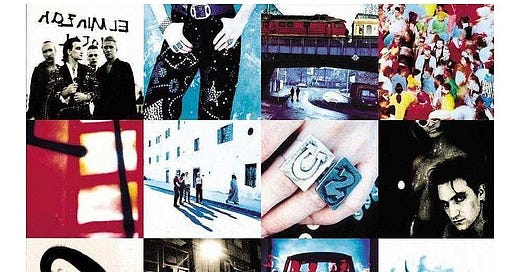During the recording session for Rattle and Hum in 1988, Bono started writing a song on the piano, not his regular songwriting mechanism. What was developed was a Jacques Brel-Esque torch song, the like that would be familiar to anyone who has heard the first couple of Scott Walker solo albums. It was even considered as a ballad for Nina Simone.
A few years later, the band were in Hansa Tonstudio recording in Berlin with Brian Eno. Looking to channel the spirit of David Bowie's trilogy of late 1970s albums recorded with the ex-Roxy Music man in what was the reunified German capital by the time of the Achtung Baby sessions.
Guitarist The Edge (David Evans) split from his wife around the time of the sessions, and the band has spoken it as the first part of their community breaking. Evans and Aislinn O'Sullivan married in 1983, so she wasn't the latest girlfriend; she'd been there for most of their time together as a band.
Bono used both the experience of The Edge’s and of another friend as inspiration, creating a falling romance song that ponders the nature of trajectory and how things happening now had been set in motion long before. He's even made the comparison to a landmine - planted many years before yet capable of wrenching despair and heartbreak. It is an apposite metaphor for a band who tied some of their mid-1990s output ("Miss Sarajevo" on Passengers being the prime example) to the Yugoslav Wars that featured 3-6 million landmines.
The track itself carries an atmosphere of deceit and betrayal, an air of menace and the threat of violence. In amongst the gospel tinge and the swooning synths manned by Eno is a sense of a broken and exhausted person driven to the brink of terrorism as the dagger aimed at their heart of love turned sour deprives them of their other feelings and emotions. It melds that seedy, pre-war era Berlin as portrayed in Cabaret, with a dense, brooding atmosphere that could almost be mistaken for Massive Attack
Bill Wyman (not the Rolling Stone) said that the guitar at the end sounds like a dentist drill1 and for The Edge, that is somewhat of a departure. We are used to hearing layered soundscapes of guitar that sound like a car slowly overtakes you on a wide-open road. Not piercing, atonal noise that wails and shrieks like that. In fact, as The Edge poured years of emotion out of his heart and into his playing, he actually snapped two guitar strings.
The track has had quite a legacy after the album was released - it was played as the last or penultimate2 song on the overwhelming majority of the Zoo TV shows, with Bono often asking a girl to dance on stage.
Since then, it has only been played twice but was covered by Jack White as the b-side to Sixteen Saltines before ending up on the soundtrack to The Great Gatsby in 2013. (More on Jack White next week…)
Personally, I like the way that the last three tracks on the album ("Ultraviolet" and "Acrobat" precede "Love Is Blindness") act as a swansong and summation of what went before, and the final track is an elegy for what is lost.
https://ew.com/article/1991/11/29/achtung-baby/
If second from last, a cover of Elvis Presley’s "Can't Help Falling In Love With You" was almost nailed on to close




